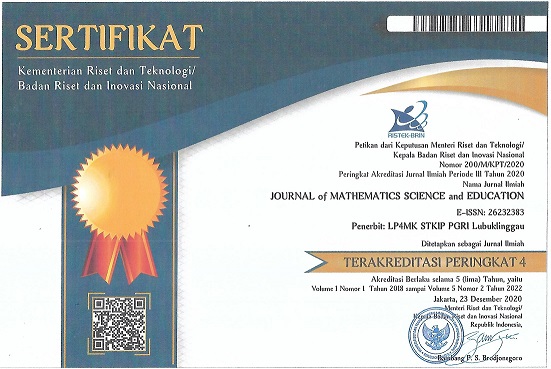PROBLEM BASED LEARNING UNTUK MENINGKATKAN KEMAMPUAN PEMECAHAN MASALAH MATEMATIS PADA MATERI PERSAMAAN KUADRAT
Abstract
This study aims to enhance students' mathematical problem-solving skills through the implementation of the Problem-Based Learning (PBL) model in the topic of quadratic equations. The research was conducted using the Classroom Action Research (CAR) method based on the Kemmis and McTaggart spiral model, consisting of two cycles with the stages of planning, action, observation, and reflection. The participants were 18 eleventh-grade students from a vocational high school (SMK) in Sleman. The findings revealed a significant improvement in students' mathematical problem-solving abilities, with the average score increasing from 75 in Cycle I to 84.72 in Cycle II. The PBL model proved effective in enhancing problem-solving skills. Challenges encountered during Cycle I, such as students' difficulties in understanding problems and lack of participation in group activities, were successfully addressed in Cycle II through improvements, including clearer visualizations in the Student Worksheets and more heterogeneous group arrangements. This study concludes that PBL is an effective teaching model for fostering meaningful learning and improving students' learning outcomes in the topic of quadratic equations.
References
Aufa, M. N., Rusmansyah, R., Hasbie, M., Jaidie, A., & Yunita, A. (2021). The effect of using e-module model Problem Based Learning (PBL) based on wetland environment on critical thinking skills and environmental care attitudes. Jurnal Penelitian Pendidikan IPA, 7(3), 401-407. https://10.29303/jppipa.v7i3.732
Arends, R. (2012). Learning to Teach. Boston: McGraw-Hill.
Boud, D., & Feletti, G. (Eds.). (2021). The Challenge of Problem-Based Learning. London: Routledge.
Christiani, F. L., & Surya, E. (2017). Analisis Model Pembelajaran Kontekstual Terhadap Kemampuan Pemecahan Masalah Matematika Pada Materi Segi Empat. Researchgate, October, 1–9.
Husni, N., & Herman, T. (2024). Analysis of Students' Mathematical Literacy Ability on High-Level Problems of PISA viewed from Gender. Jurnal Didaktik Matematika, 11(2), 219-234. https://doi.org/10.24815/jdm.v11i2.39445
Hmelo-Silver, C. E. (2004). Problem-Based Learning: What and How Do Students Learn? Educational Psychology Review, 16(3), 235–266. https://doi.org/10.1023/B:EDPR.0000034022.16470.f3
Kemmis, S., McTaggart, R., Nixon, R. (2014). Introducing Critical Participatory Action Research. In: The Action Research Planner. Springer, Singapore. https://doi.org/10.1007/978-981-4560-67-2_1
Marchy, F., Murni, A., & Muhammad, I. (2022). The Effectiveness of Using Problem-Based Learning (PBL) in Mathematics Problem-Solving Ability for Junior High School Students. AlphaMath: Journal of Mathematics Education, 8(2), 185-198. https://10.30595/alphamath.v8i2.15047
Musna, R. R., Juandi, D., & Jupri, A. (2021, May). A meta-analysis study of the effect of Problem-Based Learning model on students’ mathematical problem-solving skills. In Journal of Physics: Conference Series (Vol. 1882, No. 1, p. 012090). IOP Publishing. https://10.1088/1742-6596/1882/1/012090
Novriani, M. R., & Surya, E. (2017). Analysis of student difficulties in mathematics problem solving ability at MTs SWASTA IRA Medan. International Journal of Sciences: Basic and Applied Research (IJSBAR), 33(3), 63-75. https://core.ac.uk/download/pdf/249335829.pdf
Polya, G. (1973). How to Solve It: A New Aspect of Mathematical Method. Princeton: Princeton University Press.
Suparman, S., Yohannes, Y., & Arifin, N. (2021). Enhancing mathematical problem-solving skills of Indonesian junior high school students through problem-based learning: a systematic review and meta-analysis. Al-Jabar: Jurnal Pendidikan Matematika, 12(1), 1-16. http://dx.doi.org/10.24042/ajpm.v12i1.8036
Surya, E. (2011). Visual Thinking and Mathematical Problem Solving of The Nation Character Development. International Seminar and Mathematical Problem Solving of The Nation Character Development Journal, 1-13
OECD (20122). ISA Results 2022 (Volume III). https://www.oecd.org/en/publications/pisa-2022-results-volumeiii_765ee8c2-en.html
Savery, J. R. (2006). Overview of Problem-Based Learning: Definitions and Distinctions. Interdisciplinary Journal of Problem-based Learning, 1(1), 9-20. http://dx.doi.org/10.7771/1541-5015.1002

This work is licensed under a Creative Commons Attribution-NonCommercial-ShareAlike 4.0 International License.

This work by Journal of Mathematics Science and Education is licensed under a Creative Commons Attribution-NonCommercial-ShareAlike 4.0 International License.


















